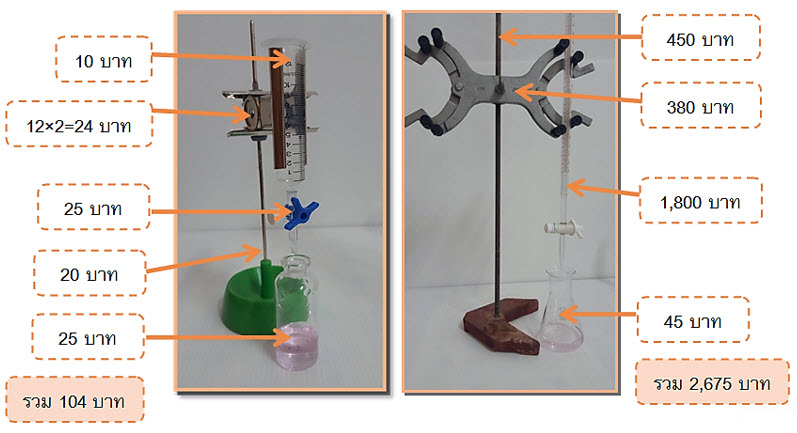ชุดการไทเทรตอย่างง่ายแบบย่อส่วนและต้นทุนต่ำสำหรับปฏิบัติการระดับไมโครในห้องเรียน
Main Article Content
Abstract
Aseesah Din-a, Suparb Tamuang, Maliwan Amatatongchai, Purim Jarujamrus and Sanoe Chairam
รับบทความ: 5 สิงหาคม 2559; ยอมรับตีพิมพ์: 1 พฤศจิกายน 2559
บทคัดย่อ
งานวิจัยนี้มีวัตถุประสงค์เพื่อสร้างชุดทดลองการไทเทรตอย่างง่ายแบบย่อส่วนและต้นทุนต่ำสำหรับปฏิบัติการระดับไมโครในห้องเรียนเคมี ชุดทดลองการไทเทรตนี้สามารถประดิษฐ์ขึ้นมาได้ง่าย ประกอบด้วยกระบอกฉีดยา (ขนาด 10 มิลลิลิตร) ข้อต่อสามทาง ขวดแก้วขนาดเล็ก (ขนาด 30 มิลลิลิตร) ฝาปิดจุกยาง เหล็กเสียบกระดาษ และคลิปหนีบกระดาษ จากผลการทดลอง พบว่า ชุดไทเทรตที่พัฒนานี้ให้ผลที่ใกล้เคียงกับชุดไทเทรตมาตรฐานมีร้อยละของความผิดพลาด (%error) ต่ำกว่าร้อยละ 5% ซึ่งถือว่าอยู่ในช่วงที่ยอมรับได้แต่ใช้ปริมาตรสารละลายน้อยลง (5.00 มิลลิลิตร) ความเข้มข้นของสารละลายมาตรฐาน 0.05 โมลต่อลิตร ชุดอุปกรณ์นี้มีต้นทุนต่ำกว่าชุดไทเทรตมาตรฐาน (104 บาท หรือ US$3) ชุดอุปกรณ์ที่พัฒนาขึ้นนี้จึงเหมาะสำหรับบริบททางการศึกษาที่ไม่สามารถเข้าถึงเครื่องมือที่ทันสมัยในหลายโรงเรียนที่อยู่ในเขตชนบทของประเทศไทย ชุดไทเทรตนี้นอกจากจะมีประโยชน์เป็นสื่อการสอนสำหรับครูแล้ว ยังเป็นการเพิ่มประสบการณ์ที่สนุกสนานสำหรับนักเรียนในห้องปฏิบัติการอีกด้วย นอกจากนี้ ครูวิทยาศาสตร์อาจประยุกต์ใช้ชุดไทเทรตที่พัฒนานี้สำหรับห้องเรียนของตนเองในรายวิชาเคมีและสาขาเกี่ยวข้องได้
คำสำคัญ: ชุดทดลองการไทเทรตอย่างง่าย การทดลองแบบย่อส่วน ต้นทุนต่ำ การไทเทรตกรด-เบส มัธยมศึกษา
Abstract
This research aimed to fabricate a simple, low-cost and small scale titration set for microscale laboratory in chemistry classroom. A titration set is simple to construct, consists of a 10-mL plastic syringe, three ways stopcock, 30-mL small vial bottle, rubber stoppers, memo spike holder and paper binder clips. The results obtained from the developed titration set were slightly different from the standard titration set. The design has been found to be precise and accurate compared to the standard titration set (<5%error) but with lesser use of samples (5.00 mL) and concentration of standard solution (0.05 mol/L). The device cost is more inexpensive than the standard titration set (฿104 or US$3). It is suitable for educational context for which there is limited access to sophisticate instruments at many schools in urban areas of Thailand. This titration set here is not only useful as teaching tool for teacher, but also enable an enjoyable experience for the students in laboratory. Furthermore, science teachers may apply the developed titration set for their classes in chemistry and related fields.
Keywords: Titration set, Small scale laboratory, Low-cost, Acid-base titration, High school
Downloads
Article Details

This work is licensed under a Creative Commons Attribution-NonCommercial 4.0 International License.
References
Abdullah, M., Mohamed, N., and Ismail, Z. H. (2009). The effect of an individualized laboratory approach through microscale chemistry experimentation on students’ understanding of chemistry concepts, motivation and attitudes. Chemistry Education Research and Practice 10(1): 53–61.
Acharry, S., and Suwannathada, J. (2010). The development of microscale laboratory: Titration. International Journal of Arts and Science 3(9): 296–305.
Acharry, S., Tambunchong, C. Wongrattana, C., and Wongsilapapirom, W. (2009). Electrochemistry: Microscale teaching module. The Journal of King Mongkut’s University of Technology North Bangkok 19(1): 11–18. (in Thai).
Cao, T., Zhang, Q., and Thompson, J. E. (2014). Designing, constructing, and using an inexpensive electronic buret. Journal of Chemical Education 92(1): 106-109.
Khattiyavong, P, Jarujamrus, P., Supasorn, S., and Kulsing, C. (2014). The development of small scale and low-cost galvanic cells as a teaching tool for electrochemistry. Journal of Research Unit on Science, Technology and Environment for Learning 5(2): 146–154. (in Thai)
Logan, S. J., and Abrams, N. M. (2012). A simple, semiquantitative device for liquid–liquid separations. Journal of Chemical Education 89(12): 1609–1610.
Singh, M. M., McGowan, C. B., Szafran, Z., and Pike, R. M. (1998). A modified microburet for microscale titration. Journal of Chemical Education 75(3): 371.
Singh, M. M., McGowan, C. B., Szafran, Z., and Pike, R. M. (2000). A comparative study of microscale and standard burets. Journal of Chemical Education 77(5): 528–626.
Skoog, D. A, West, D. M., Holler, F. J., and Crouch, S. R. (2013). Fundamentals of Analytical Chemistry. Singapore: Brook/Cole Cengage Learning.
Villalón, G. C. (2013). Adapting bottles to digital burets for small volume titration. Journal of Chemical Education 90(7): 952.
Wooster, M. (2007). Microscale chemistry. Education in Chemistry 44(2): 45–47.
